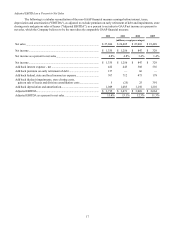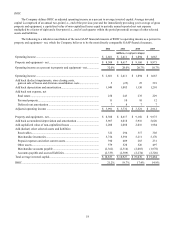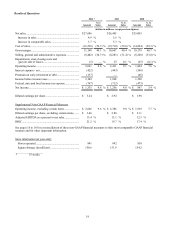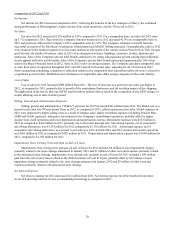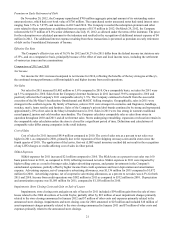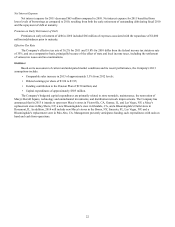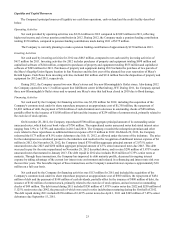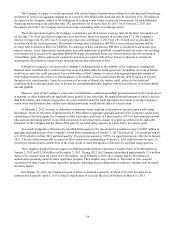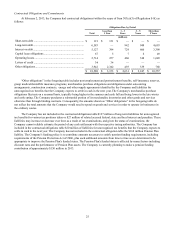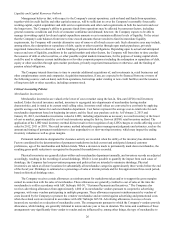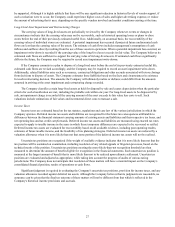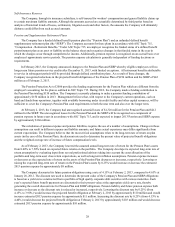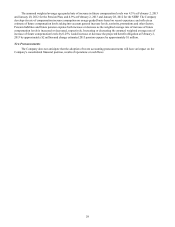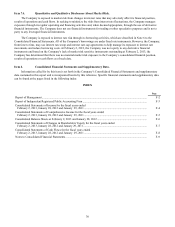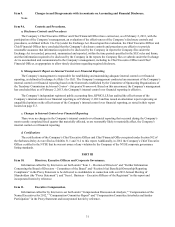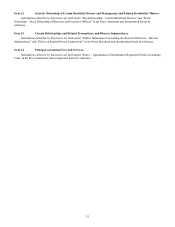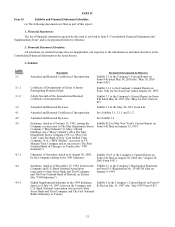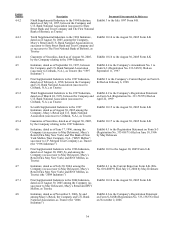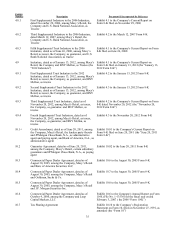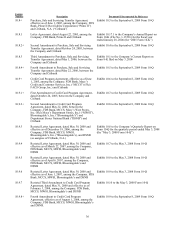Macy's 2012 Annual Report Download - page 32
Download and view the complete annual report
Please find page 32 of the 2012 Macy's annual report below. You can navigate through the pages in the report by either clicking on the pages listed below, or by using the keyword search tool below to find specific information within the annual report.27
be supported. Although it is highly unlikely that there will be any significant reduction in historical levels of vendor support, if
such a reduction were to occur, the Company could experience higher costs of sales and higher advertising expense, or reduce
the amount of advertising that it uses, depending on the specific vendors involved and market conditions existing at the time.
Long-Lived Asset Impairment and Restructuring Charges
The carrying values of long-lived assets are periodically reviewed by the Company whenever events or changes in
circumstances indicate that the carrying value may not be recoverable, such as historical operating losses or plans to close
stores before the end of their previously estimated useful lives. Additionally, on an annual basis, the recoverability of the
carrying values of individual stores are evaluated. A potential impairment has occurred if projected future undiscounted cash
flows are less than the carrying value of the assets. The estimate of cash flows includes management's assumptions of cash
inflows and outflows directly resulting from the use of those assets in operations. When a potential impairment has occurred, an
impairment write-down is recorded if the carrying value of the long-lived asset exceeds its fair value. The Company believes its
estimated cash flows are sufficient to support the carrying value of its long-lived assets. If estimated cash flows significantly
differ in the future, the Company may be required to record asset impairment write-downs.
If the Company commits to a plan to dispose of a long-lived asset before the end of its previously estimated useful life,
estimated cash flows are revised accordingly, and the Company may be required to record an asset impairment write-down.
Additionally, related liabilities arise such as severance, contractual obligations and other accruals associated with store closings
from decisions to dispose of assets. The Company estimates these liabilities based on the facts and circumstances in existence
for each restructuring decision. The amounts the Company will ultimately realize or disburse could differ from the amounts
assumed in arriving at the asset impairment and restructuring charge recorded.
The Company classifies certain long-lived assets as held for disposal by sale and ceases depreciation when the particular
criteria for such classification are met, including the probable sale within one year. For long-lived assets to be disposed of by
sale, an impairment charge is recorded if the carrying amount of the asset exceeds its fair value less costs to sell. Such
valuations include estimations of fair values and incremental direct costs to transact a sale.
Income Taxes
Income taxes are estimated based on the tax statutes, regulations and case law of the various jurisdictions in which the
Company operates. Deferred income tax assets and liabilities are recognized for the future tax consequences attributable to
differences between the financial statement carrying amounts of existing assets and liabilities and their respective tax bases, and
net operating loss and tax credit carryforwards. Deferred income tax assets and liabilities are measured using enacted tax rates
expected to apply to taxable income in the years in which those temporary differences are expected to be recovered or settled.
Deferred income tax assets are evaluated for recoverability based on all available evidence, including past operating results,
estimates of future taxable income, and the feasibility of tax planning strategies. Deferred income tax assets are reduced by a
valuation allowance when it is more likely than not that some portion of the deferred income tax assets will not be realized.
Uncertain tax positions are recognized if the weight of available evidence indicates that it is more likely than not that the
tax position will be sustained on examination, including resolution of any related appeals or litigation processes, based on the
technical merits of the position. Uncertain tax positions meeting the more-likely-than-not recognition threshold are then
measured to determine the amount of benefit eligible for recognition in the financial statements. Each uncertain tax position is
measured at the largest amount of benefit that is more likely than not to be realized upon ultimate settlement. Uncertain tax
positions are evaluated and adjusted as appropriate, while taking into account the progress of audits of various taxing
jurisdictions. The Company does not anticipate that resolution of these matters will have a material impact on the Company's
consolidated financial position, results of operations or cash flows.
Significant judgment is required in evaluating the Company's uncertain tax positions, provision for income taxes, and any
valuation allowance recorded against deferred tax assets. Although the Company believes that its judgments are reasonable, no
assurance can be given that the final tax outcome of these matters will not be different from that which is reflected in the
Company's historical income provisions and accruals.


